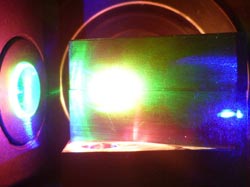Mainz laser system allows determination of atomic binding energy of the rarest element on earth

Close-up of the Mainz laser system<br> photo: Pascal Naubereit<br>
The radioactive element astatine, the name of which is derived from the Greek word for 'instability,' is so rare on earth that it has not yet been investigated to any greater extent and, as a consequence, very little is known about it.
Using artificially generated astatine, the Mainz-based physicist Sebastian Rothe has now managed for the first time to experimentally explore one of its fundamental parameters, the ionization potential, and thus determine one of the most important properties of the rare element.
The ionization potential is the binding energy, i.e., the amount of energy required to remove an electron from an atom's outer shell. It determines the entire chemical binding characteristics of that element. The measurements were undertaken at the laboratory of the CERN European Organization for Nuclear Research near Geneva using special lasers developed by the LARISSA working group at the Institute of Physics at Johannes Gutenberg University Mainz (JGU). The online journal Nature Communications recently published the findings.
Astatine is the rarest naturally occurring element on earth. The earth's mantel is estimated to contain only 0.07 grams. Together with fluorine, chlorine, and iodine, it is a member of the halogen group, and is formed as a result of the natural decay of uranium. Nuclear physicists now know of more than 20 isotopes which are all extremely short-lived and decay with a half-life of no more than eight hours. Alpha rays are emitted during decay, making the element particularly interesting for targeted cancer therapy thanks to its short lifespan. “Astatine is the only halogen we have known absolutely nothing about to date”, explained Professor Klaus Wendt, head of the LARISSA working group at the Institute of Physics at Johannes Gutenberg University Mainz (JGU).
A doctoral candidate and member of this work group, Sebastian Rothe, investigated the ionization potential of astatine using laser spectroscopy and determined it had a value of 9.31751 electron volts (eV). The measurements were conducted at CERN in Geneva and were extrapolated and confirmed at the Canadian research center for particle and nuclear physics TRIUMF in Vancouver in Canada.
LARISSA is an acronym for 'Laser Resonance Ionization for Spectroscopy in Selective Applications'. The technique is based on work originally conducted by Mainz physicist Professor Ernst Otten more than 30 years ago using the isotope mass separator ISOLDE at CERN. It is now the technique of choice employed at almost all large-scale research facilities throughout the world to produce and examine exotic radioisotopes and is commonly used applying the Mainz laser system. It involves the use of laser light for the gradual optical excitation of a valence electron of a selected atomic species until the point of ionization.
“Astatine is the last naturally occurring element whose ionization potential had yet to be determined experimentally,” stated Rothe. The binding energy of the electrons in its outermost shell determines what chemical reactions astatine will undergo and thus the stability of its chemical bonds. It is believed that the astatine isotope 211 may have a major pharmaceutical potential. It is an exceptional candidate for use in cancer therapy because of its decay profile, the aggressiveness of its alpha radiation, and the limited range of its radiation. It is also a member of the halogen family, which can be readily introduced into the human body to be attached directly to cancer cells.
Publication
Sebastian Rothe et al.
Measurement of the first ionization potential of astatine by laser ionization spectroscopy
Nature Communications, May 2013
DOI: 10.1038/ncomms2819
http://www.nature.com/ncomms/journal/v4/n5/full/ncomms2819.html
Images
http://www.uni-mainz.de/bilder_presse/08_physik_quantum_astat_01.jpg
Close-up of the Mainz laser system
photo: Pascal Naubereit
http://www.uni-mainz.de/bilder_presse/08_physik_quantum_astat_02.jpg
View of the Mainz laser system
photo: Pascal Naubereit
Contact and further information
Professor Dr. Klaus Wendt
Larissa work group
Institute of Physics
Johannes Gutenberg University Mainz (JGU)
D 55099 Mainz, GERMANY
phone +49 6131 39-22882
fax +49 6131 39-23428
e-mail: klaus.wendt@uni-mainz.de
http://www.larissa.physik.uni-mainz.de/index_ENG.php
Media Contact
All latest news from the category: Physics and Astronomy
This area deals with the fundamental laws and building blocks of nature and how they interact, the properties and the behavior of matter, and research into space and time and their structures.
innovations-report provides in-depth reports and articles on subjects such as astrophysics, laser technologies, nuclear, quantum, particle and solid-state physics, nanotechnologies, planetary research and findings (Mars, Venus) and developments related to the Hubble Telescope.
Newest articles

First-of-its-kind study uses remote sensing to monitor plastic debris in rivers and lakes
Remote sensing creates a cost-effective solution to monitoring plastic pollution. A first-of-its-kind study from researchers at the University of Minnesota Twin Cities shows how remote sensing can help monitor and…

Laser-based artificial neuron mimics nerve cell functions at lightning speed
With a processing speed a billion times faster than nature, chip-based laser neuron could help advance AI tasks such as pattern recognition and sequence prediction. Researchers have developed a laser-based…

Optimising the processing of plastic waste
Just one look in the yellow bin reveals a colourful jumble of different types of plastic. However, the purer and more uniform plastic waste is, the easier it is to…


